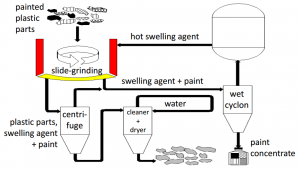My Projects
Topic: Paint stripping
Title: Recycling of Painted Plastic Parts
The sketch presents a process for paint stripping from plastic parts:
A slide-grinding machine removes the paint layer on arbitrarily formed plastic parts all over.
For more selectivity, the paint is additionally softened by a hot swelling agent,
which is introduced to the process in a closed loop by a well-tempered reservoir.
The swelling agent is recovered by means of a centrifuge from the parts
and by means of a wet cyclone from the paint, respectively.
.
What one doesn’t see:
Paint is a protection for plastics from decomposition by weathering. Unpainted plastic parts decompose by environmental influences, such as UV radiation, oxidation, humidity, microbes or thermo-mechanical fatigue TMF. Yet, a quite thin cover with paint protects effectively and durable from a material degeneration by the employment of few functional additives, such UV absorbers, antioxidants, impregnation barriers, and deflectors. However, for recycling purposes, even a comparably small amount of paint turns out to be detrimental. Embedded in the bulk material paint chips work like notches for mechanical stress and reduce drastically the mechanical loading capacity.
What’s behind it:
To achieve high-grade recycling – and avoid downcycling – plastic parts for exterior applications should be painted and paint stripped after use. In this way a reconditioned recyclate can be obtained as good as new – even after several years of exposure to the environment.
What you can obtain from it:
Durable consumer goods – such as cars or buildings – employ large-sized cover panels of plastic material for the outer appearance and shielding. For example, shock bumpers from cars accumulate in big numbers by repair and scrapping – and they consist of expensive plastic material. For disintegration and transport, the unwieldy parts are shredded and handled as bulk material. Since the described paint stripping process is independent of the particular forms, even a mechanical recycling becomes feasible, where a virgin material is substituted.
My related publications:
Reprocessing Painted Plastic Parts, Proceedings R’95, Geneve, Switzerland, III, 44-49 (1995)
Chemo-Mechanical Stripping of Paint from Plastic Parts, patent US 5578135 A
